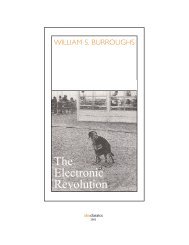Franco ''Bifo'' Berardi - The Soul at Work From Alienation to Autonomy
Franco ''Bifo'' Berardi - The Soul at Work From Alienation to Autonomy
Franco ''Bifo'' Berardi - The Soul at Work From Alienation to Autonomy
Create successful ePaper yourself
Turn your PDF publications into a flip-book with our unique Google optimized e-Paper software.
velocity in the rel<strong>at</strong>ion between st<strong>at</strong>es and milit<strong>at</strong>y blocs tnroUI;!1out.<br />
the modern period. But the velocity of class struggle, the war<br />
between working class and capital, was even more decisive. Digital<br />
technology and the financial character of the world economy have<br />
acceler<strong>at</strong>ed the pace of capital transfers, of changes in the organiza_<br />
tion of work and the cre<strong>at</strong>ion and dismantling of productive<br />
centers all around the world. This accelet<strong>at</strong>ion obstructs the for_<br />
m<strong>at</strong>ion of communities in the places where capital starts the<br />
productive process.<br />
While industrial labor did not imply communic<strong>at</strong>ion and did<br />
not <strong>at</strong>tract desiring energies, the opposite can be said for cognitive<br />
labor. Info-workers can sometimes be described as craftsmen, since<br />
they invest their knowledge and cre<strong>at</strong>ivity in the process of p<strong>to</strong>ducing<br />
networks. <strong>The</strong>ir energy is displaced from one point of the<br />
productive network <strong>to</strong> rhe other: capturing fragments of inform<strong>at</strong>ion<br />
in order <strong>to</strong> recombine them within a constantly changing<br />
general frame.<br />
<strong>The</strong> investment of desire, which for the craftsman deeply<br />
connected <strong>to</strong> its local community and its needs used <strong>to</strong> have a<br />
reassuring character, for me info-worker develops along very different<br />
lines, producing anxiety, incertitude and constant change. Flexibility<br />
is the necessity <strong>to</strong> displace, move, and constantly change perspec"<br />
tives. This is the double-sided fulcrum of desire and productivity<br />
for the info-worker. Experience, knowledge and flux are <strong>at</strong> the<br />
same time the constitutive aspects of existence and the context of<br />
active labor.<br />
Cognitive labor is essentially a labor of communic<strong>at</strong>ion, th<strong>at</strong><br />
is <strong>to</strong> say communic<strong>at</strong>ion put <strong>to</strong> work. F<strong>to</strong>m a certain point of<br />
view, this could be seen as an entichment of experience. But it is<br />
also (and this is generally the rule) an impoverishment, since<br />
'COJiIlnlUJlic<strong>at</strong>lon loses its character of gr<strong>at</strong>ui<strong>to</strong>us, pleasurable and<br />
contact, becoming an economic necessity, a joyless fiction.<br />
Moreover, not all forms of work th<strong>at</strong> could somehow be<br />
defined as mental activities are linked <strong>to</strong> communic<strong>at</strong>ion, invention<br />
and cre<strong>at</strong>ion. A characteristic aspect of info-labor is the fact<br />
th<strong>at</strong> it cannot be reduced <strong>to</strong> any c<strong>at</strong>egory, not even <strong>to</strong> deterri<strong>to</strong>rializ<strong>at</strong>ion<br />
or <strong>to</strong> au<strong>to</strong>nomy or cre<strong>at</strong>iviry. <strong>The</strong> people who sit <strong>at</strong> their<br />
terminals in front of a screen, repe<strong>at</strong>ing every day the same oper<strong>at</strong>ion<br />
a thousand times, rel<strong>at</strong>e <strong>to</strong> their labor in a way similar <strong>to</strong><br />
industrial workers. Wh<strong>at</strong> we need <strong>to</strong> understand, though, is the<br />
new element, the fact th<strong>at</strong> cre<strong>at</strong>ive labor in the network circle is<br />
infinitely flexible, it can be assembled and disassembled, and th<strong>at</strong> it<br />
is precisely in this dismantling identific<strong>at</strong>ion th<strong>at</strong> we can find both<br />
its desire and its anxiety. Within mental labor as a whole we need<br />
distinguish properly cognitive labot, where intellectual energies are<br />
engaged in a constant cre<strong>at</strong>ive deterri<strong>to</strong>rializ<strong>at</strong>ion, and mental<br />
labor of a purely applic<strong>at</strong>ive kind, which is still prevalent quantit<strong>at</strong>ively.<br />
Even within the mental labor cycle, we can distinguish brain<br />
workers from chain workers. But I'll focus on the most innov<strong>at</strong>ive<br />
and specific forms, since they represent the trend th<strong>at</strong> is transfo<br />
rming the whole of social production.<br />
Cognitive labor in me network<br />
In order <strong>to</strong> understand the transform<strong>at</strong>ion th<strong>at</strong> social perception of<br />
labor underwent during the past few decades and how it determined<br />
the workers' condition of cultutal and psychological<br />
dependence, we need <strong>to</strong> analyze both the investments of desire<br />
within rhe domain of info production and the formal aspects of<br />
labor rel<strong>at</strong>ions.<br />
86 / <strong>The</strong> <strong>Soul</strong> <strong>at</strong> <strong>Work</strong><br />
<strong>The</strong> SOUl <strong>at</strong> <strong>Work</strong> J 87




